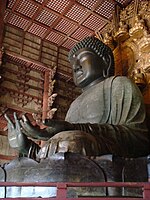| This article relies largely or entirely on a single source. Relevant discussion may be found on the talk page. Please help improve this article by introducing citations to additional sources. Find sources: "Aṅgaja" – news · newspapers · books · scholar · JSTOR (January 2024) |

Aṅgaja (Japanese: 因掲陀尊者, Ingada sonja) is one of the Sixteen Arhats or Rakan (Japanese: 十六羅漢, Juroku Rakan) of Buddhism, saintly men who were predecessors or disciples of the Buddha. Other such arhats are Binzuru sonja, Ragora sonja, Chudahandaka sonja etc... Aṅgaja is part of the Buddhist Pantheon of Mahayana and Vajrayana Buddhism. He also appears, with other Rakan except for Binzuru sonja, in the Temples and Monasteries of Zen Buddhism, where they are shown as models to be emulated.
